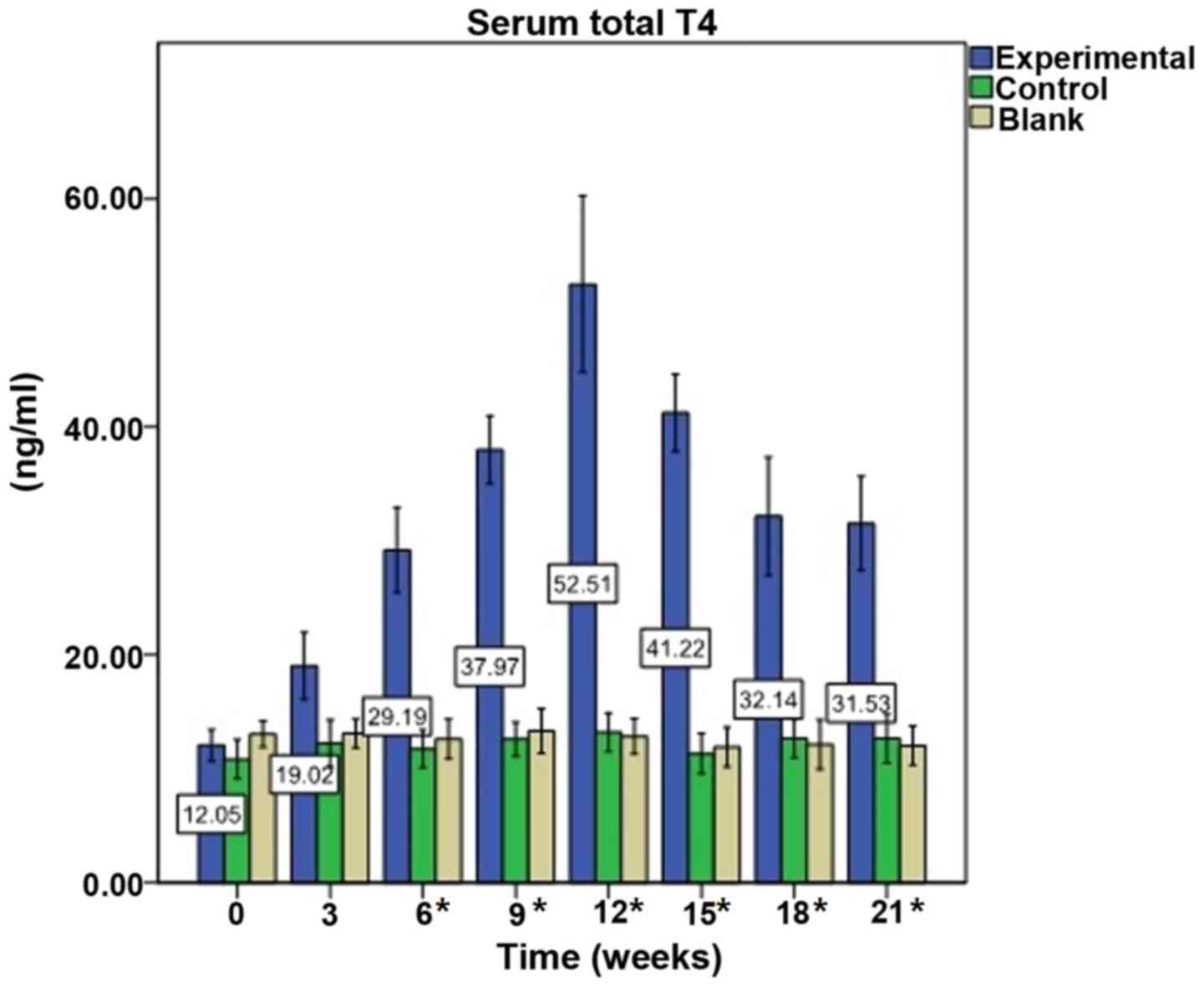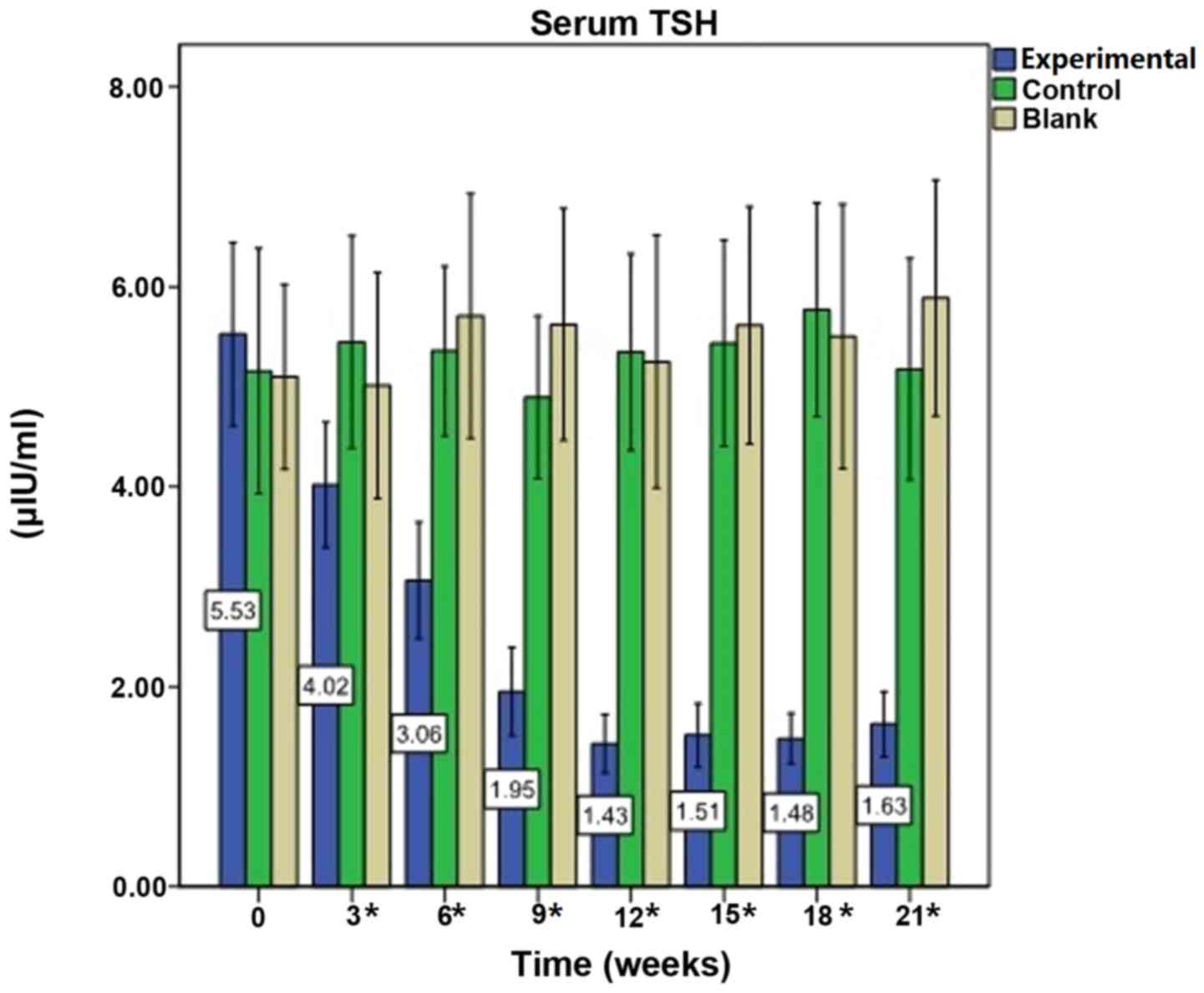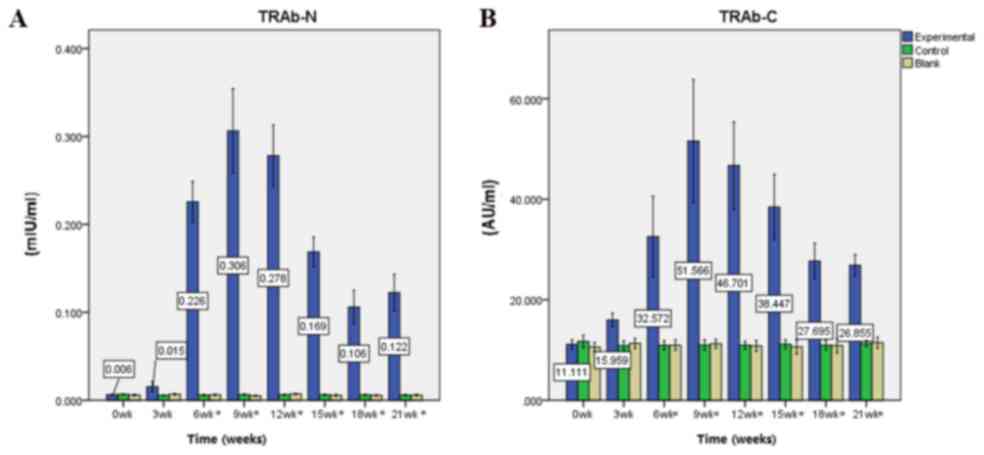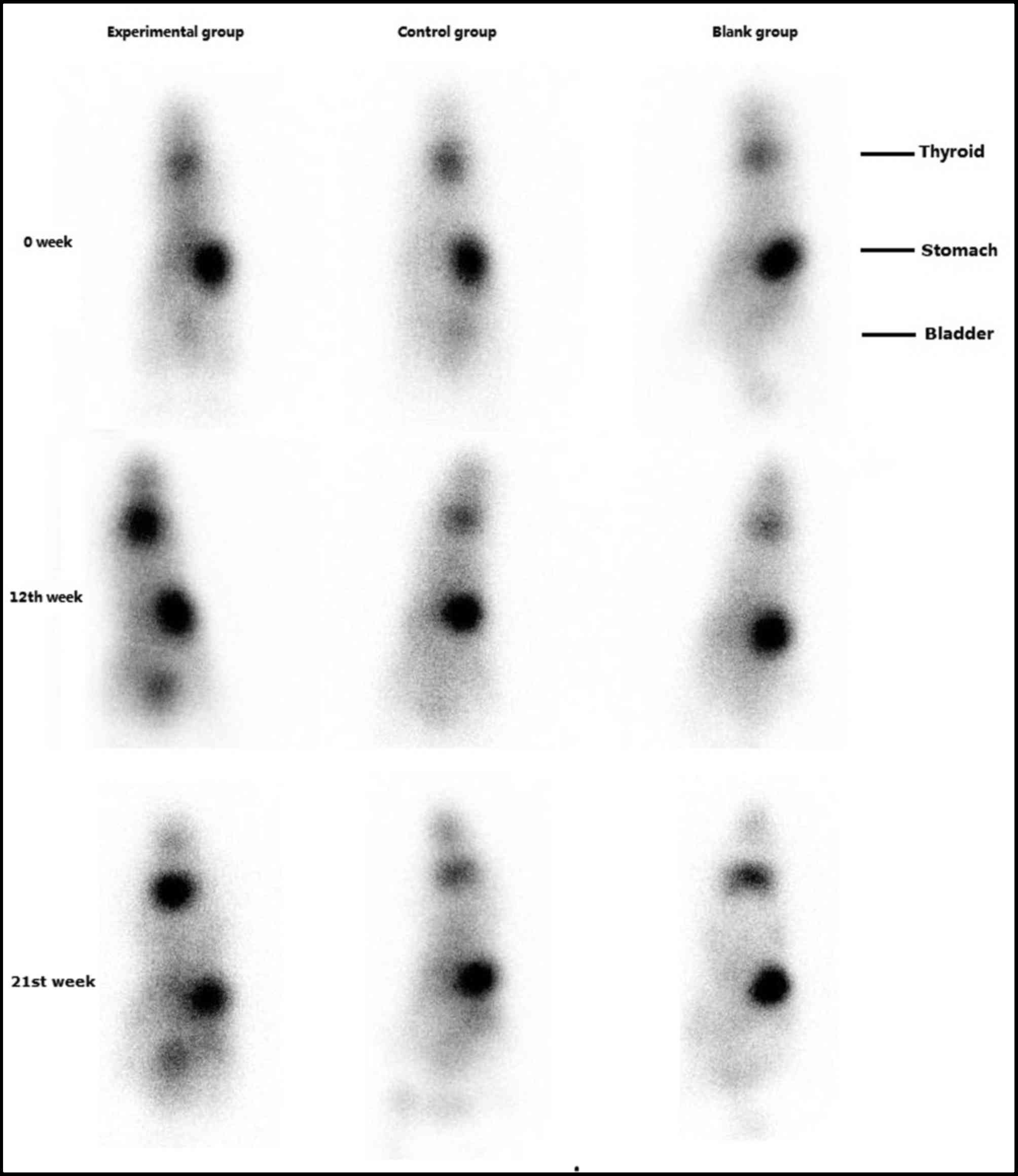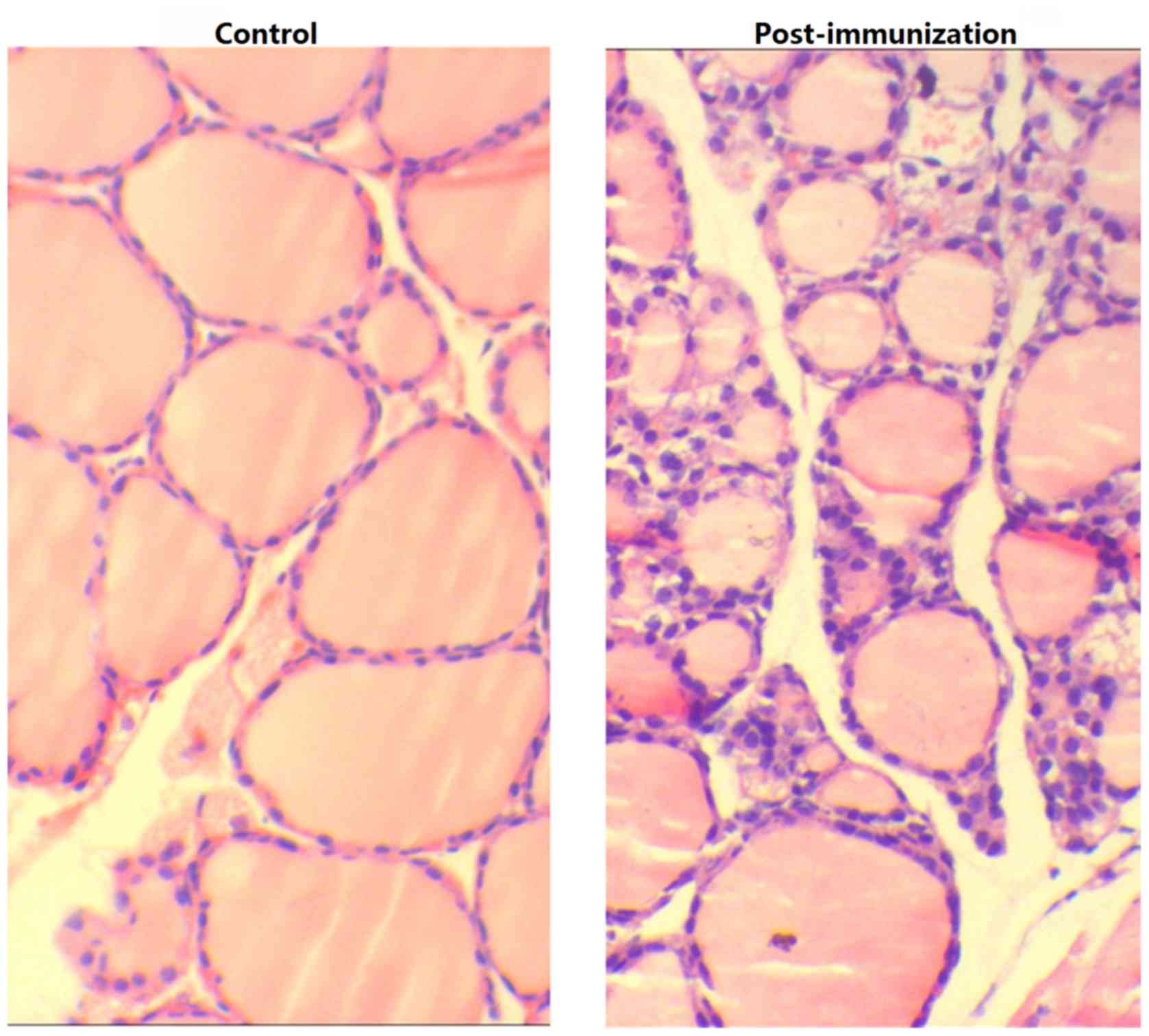An improved method for the establishment of a model of Graves' disease in BALB/c mice
- Authors:
- Published online on: February 8, 2017 https://doi.org/10.3892/mmr.2017.6181
- Pages: 1471-1478
-
Copyright: © Zheng et al. This is an open access article distributed under the terms of Creative Commons Attribution License.
Abstract
Introduction
Thyrotoxicosis is a condition with multiple etiologies, manifestations and potential therapies. The term ‘thyrotoxicosis’ refers to a clinical state that results from increased thyroid hormone levels in tissues. The most common manifestation is termed Graves' disease (GD). In China, the prevalence of GD is approximately 1.1–1.4% (1). GD is an organ-specific autoimmune thyroid disease with a genetic predisposition. Typical features of GD include high metabolic syndrome, goiter and Graves' orbitopathy (GO). Patients with GD should be treated with any of the following modalities: Anti Thyroid Drugs (ATDs), radioactive iodine (RAI) therapy, or thyroidectomy. In China, ATD therapy has been the most preferred by physicians, however recent developments have suggested an increase in the use of RAI therapy to reduce the use of ATDs. In GD, the generation of an autoantibody, thyrotrophin receptor antibody (TRAb), against the thyroid-stimulating hormone (TSH) receptor (TSHR) causes continuous stimulation of the thyroid gland and hyperthyroidism (2,3). The precise immunological mechanism of TRAb production, however, remains elusive. Previous studies have indicated that TRAb is detected in the serum of most patients with GD (4,5). TRAb is an important independent risk factor for GD (6). The titer of TRAb influences the duration of ATD therapy and the dose of RAI therapy (7). The establishment of a GD animal model allows the study of its etiology and potential therapeutic targets. In recent years, various animal models of GD have been developed that have demonstrated an autoimmune response to TSHR. Two attempts were made to immunize mice using human TSHR: one via the injection of TSHR-transfected cells simultaneously expressing MHC class II (8), and the other by genetic immunization using TSHR cDNA (9). These immunized mice demonstrated typical phenotypes associated with hyperthyroidism, however the response was temporary and TRAb was produced against non-self TSHR. The process of autoantibody production in these mice presumably lacks the persistent abrogation of self-tolerance. The present study investigated an improved method for inducing GD in BALB/c mice by injecting the recombinant plasmid pcDNA3.1/TSHR268 and performing electroporation (EP). This novel method has numerous advantages, including a short model cycle, high success rates, stability and reproducibility. This model may not precisely mimic human disease; however, the present study forms a theoretical basis for further study on the etiology and pathogenesis of GD, and for the development of novel therapeutic strategies.
Materials and methods
Materials
A total of 90 female BALB/c mice (age, 6–8 weeks; weight, 18–20 g) were obtained from the Institute of Laboratory Animal Sciences, Chinese Academy of Medical Sciences (Beijing, China). All the animals were housed in individual cages with a constant temperature (18–20°C) and humidity (65–69%) at 12/12 h light/dark cycle with free access to food and water. The experimental procedures were approved by the animal ethics committee of Tianjin Medical University. EP was performed using an ECM®830 electroporater (BTX; Harvard Apparatus, Holliston, MA, USA). Pertechnetate (99mTcO4-) was produced by a molybdenum technetium generator (China Institute of Atomic Energy, Beijing, China). The mice were imaged using a single-photon emission computer tomography (SPECT) machine (Discovery NM-670; GE Healthcare Life Sciences, Shanghai, China).
Preparation of recombinant plasmid pcDNA3.1/TSHR268
Total RNA was extracted from healthy human thyroid tissue and reverse transcribed. The tissue was obtained from male and female adult patients, during the resection of benign thyroid nodules. The Total RNA extraction kit (Protein and RNA Extraction Kit) and reverse transcription kit (PrimeScript 1st Strand cDNA Synthesis kit) were supplied by Takara Biotechnology Co., Ltd. (Dalian, China). The experiments were performed following the manufacturer's protocol. The experimental procedures and materials were approved by the ethics committee of Tianjin Medical University General Hospital. Human TSHR 164–967 bp (TSHR268) was amplified by polymerase chain reaction (PCR) using the following primer sequences: Forward, 5′-ACGCGAATTCGCCACCATGGGGTGTTCGTCTCC-3 and reverse, 5′-AGGCGGATCCCTGATTCTTAAAAGCACAGCAGT-3. The PCR reaction mixture contained: 0.25 µl Pyrobest™ DNA polymerase (Takara Biotechnology Co., Ltd.), 5 µl 10X Pyrobest buffer, 4 µl 2′-deoxynucleoside 5′-triphosphates mix (2.5 mmol/l), 1 µl upstream primer (20 µmol/l), 1 µl downstream primer (20 µmol/l), 2.5 ng template cDNA and deionized water to a final volume of 50 µl. The cycling conditions were as follows: Pre-denaturation at 94°C for 4 min, followed by 30 cycles of denaturation at 94°C for 45 sec, annealing at 56°C for 30 sec and extension at 72°C for 1 min, and a final extension step at 72°C for 5 min. The PCR product was cloned into the pcDNA3.1 vector by pcDNA3.1/V5-His TOPO TA Expression Kit (Invitrogen; Thermo Fisher Scientific, Inc., Waltham, MA, USA). The experimental procedure was conducted according to the manufacturer's protocol.
Experimental groups
The BALB/c mice were randomly divided into experimental (n=50), control (n=20) and blank (n=20) groups. Mice were injected with the recombinant plasmid pcDNA3.1/TSHR268 (experimental group) or an equal volume of saline (control and blank groups). Experimental and control group mice were subjected to EP.
Establishment of the GD mouse model
Mice were anesthetized with an intraperitoneal injection of 50 mg/kg sodium pentobarbital (Shanghai Haling Biotechnology Co., Ltd., Shanghai, China). At weeks 1, 4, 7 and 10, recombinant plasmid pcDNA3.1/TSHR268 (50 µl, 1 g/l) was injected into the bilateral gastrocnemius of experimental group mice. An equal volume of saline was injected into the control and blank group mice at the same time. The experimental and control group mice were subjected to EP at the same time and location to enhance immunization. For EP, a pair of electrode needles was injected into the muscle across the site at which the recombinant plasmid was injected. Electric pulses were delivered using an electroporator. A total of three 50 V pulses and three additional pulses of the opposite polarity were administered at each injection site at a rate of one pulse per 200 msec, a frequency of 5 pulses/sec and a duration of 50 msec (10).
T4 and TSH measurements
Blood from the angular vein was collected to measure the levels of total serum T4 and serum TSH using radioimmunoassay and immunoradiometric kits, respectively (Beijing North Institute of Biotechnology, Beijing, China) 7 to 10 days after each immunization and every three weeks until week 21.
ELISA for measuring TRAb N-terminal (N) and C-terminal (C)
Blood from the angular vein was collected to measure the levels of TRAb N and C by ELISA at the same time points as above. Thyroid-stimulating antibody (TSAb) was used in the N method and thyroid stimulation blocking antibody (TSBAb) was used in the C method, as respective antigens. A total of two ELISA methods for the detection of TSAb and TSBAb have been established and evaluated by our laboratory (11). The absorbance value A450 served as the quantitative parameter to reflect the levels of TRAb. TRAb C levels were measured in arbitrary units per milliliter (AU/ml) (12).
99mTcO4− radioactive isotope imaging
Whole body 99mTcO4- imaging was performed at weeks 0, 12 and 21. A total of three mice from each group were randomly selected and anesthetized with pentobarbital. 99mTcO4- was intraperitoneally injected into each mouse (37 MBq/0.1 ml). Scintigraphy was performed 10 min later using a SPECT machine. A low-energy universal collimator was used for imaging. The imaging conditions were as follows: Energy peak, 140 keV; matrix, 128×256; magnification, 3.0; and counts, 3×105.
Weight, thyroid morphology and pathology analysis
All mice were weighed 7 to 10 days following each immunization and every three weeks until week 21. They were subsequently sacrificed by cervical vertebra dislocation at the end of week 21. The thyroid glands were removed and fixed with 10% formalin. After one week, the tissue was embedded in paraffin blocks, sectioned and stained with hematoxylin and eosin for analysis (13).
Statistical analysis
Data were analyzed using an independent samples t-test or one-way analysis of variance followed by a least significant difference post hoc test. SPSS software version 19.0 (IBM SPSS, Armonk, NY, USA) was used to analyze the data. Data are expressed as the mean ± standard deviation or number (%). P<0.05 was considered to indicate a statistically significant difference.
Results
Induction of GD in mice
During the course of the experiment, two mice in the experimental group and one in the blank group died. Prior to the experiment, T4, and TRAb N and C levels of all mice in the experimental group were within the same range as those in the control and blank groups. At the end of the immunization protocol (week 12), 38 of the 48 mice in the experimental group had increased levels of T4, and TRAb N and C. All 38 mice demonstrated reduced levels of TSH. The rate of disease induction was therefore 79.17%.
Immunization elevates serum T4 levels
Prior to immunization (week 0), baseline mean levels of T4 in the experimental mice were 12.05±4.23 ng/ml. Following the first immunization, the mean levels of T4 increased slowly and peaked following the fourth immunization at week 12, where T4 was 52.51±23.58 ng/ml (P<0.0001). T4 levels decreased from weeks 15 to 21; however, they remained significantly increased compared with pre-immunization levels (all P=0.000). T4 levels in the control group were 13.21±3.73 ng/ml at week 12 vs. 10.84±3.79 ng/ml at week 0 (P=0.593), and in the blank group were 12.84±3.36 ng/ml at week 12 vs. 13.03±2.47 ng/ml at week 0 (P=0.892). There were no significant alterations in T4 levels in the control and blank groups during the experiment (Fig. 1).
Immunization reduces serum TSH levels
Prior to immunization (week 0), baseline mean levels of serum TSH in the experimental mice were 5.53±2.78 µIU/ml. Following the first immunization, the mean levels of TSH declined (all P<0.0001). During the course of the experiment, TSH levels fluctuated; however, they remained reduced compared with pre-immunization levels (all P<0.0001). TSH levels in the control group were 5.35±2.17 µIU/ml at week 12 vs. 5.16±2.70 µIU/ml at week 0 (P=0.969), and in the blank group were 5.25±2.72 µIU/ml at week 12 vs. 5.10±1.99 µIU/ml at week 0 (P=0.960). There were no significant alterations in serum TSH levels in the control and blank groups (Fig. 2).
Immunization elevates TRAb N and C levels
Prior to immunization (week 0), baseline mean levels of serum TRAb N and C in experimental mice were 0.006±0.002 mIU/ml and 11.111±2.808 AU/ml, respectively. Following the first immunization, the mean levels of TRAb N and C increased steadily. Following the third immunization at week nine, TRAb N and C levels peaked at 0.306±0.146 mIU/ml and 51.566±37.357 AU/ml, respectively (all P<0.0001). From the fourth immunization (week 12) to the end of the experiment (week 21), the mean levels of TRAb N and C decreased; however, they remained significantly increased compared with pre-immunization levels (TRAb C at week 21, P=0.001, the rest P<0.0001). TRAb N levels in the control group were 0.006±0.002 mIU/ml at week 9 vs. 0.007±0.002 mIU/ml at week 0 (P=0.520), and in the blank group were 0.005±0.002 mIU/ml at week 9 vs. 0.006±0.002 mIU/ml at week 0 (P=0.885). TRAb C levels in the control group were 10.97±2.35 AU/ml at week 9 vs. 11.69±2.78 AU/ml at week 0 (P=0.933), and in the blank group were 11.25±1.91 AU/ml at week 9 vs. 10.59±1.99 AU/ml at week 0 (P=0.939). There were no significant alterations in TRAb N and C levels in the control and blank groups (Fig. 3).
99mTcO4− radioactive isotope imaging
There were no significant differences in thyroid 99mTcO4- uptake between the three groups prior to immunization. Following the fourth immunization (week 12), the uptake of 99mTcO4- by the thyroid was increased in the experimental group. At week 21, this remained increased compared with pre-immunization levels. There were no significant alterations in 99mTcO4- thyroid uptake in the control and blank groups (Fig. 4).
Weight, thyroid morphology and pathology analysis
At week 0, the mean weights of mice in the three groups were similar. The weight of mice increased steadily during the experiment in all groups. At week 21, the mean weight of the experimental mice was significantly reduced compared with the blank and control groups (Table I).
The thyroid glands from experimental group mice exhibited diffuse enlargement with hypertrophy, unlike the blank and control mice (Fig. 5). Examination of the thyroid tissue via microscopy revealed lymphocyte infiltration, fewer colloid nodules and an increase in the height of epithelial cells in experimental mice compared with blank and control group mice (Fig. 6).
Discussion
The immunological processes involved in autoimmune thyroid disease, including GD, are hypothesized to be mediated primarily by antibodies, similarly to other autoimmune diseases (14). Hyperactivity of the thyroid gland is the result of thyroid-stimulating antibodies, which are now considered to recognize and activate the TSHR. One of the unique characteristics of GD is the presence of TRAb, which is detectable in the serum of the majority of patients with the disease, and leads to hyperplasia and hyperfunctioning of the thyroid gland due to activation of the thyrotropin receptor (4,5,15). Our previous study demonstrated that, as one of the most important risk factors for GD, TRAb influenced prognosis and treatment efficacy, particularly in female patients (16). A total of three varieties of TRAb are present in most GD patients: TSAb, TSBAb and a neutral antibody. TSAb and TSBAb bind to the N- and C-terminal regions of the TSHR extracellular domain, respectively. It is hypothesized that TSAb serves a central role in the pathogenesis of GD, by stimulating TSH-mediated activation of thyroid function. However, TSBAb may act as a weak TSH agonist to induce hypothyroidism by preventing TSH from binding to the receptor. The neutral TSHR antibody does not block TSH binding or action (17). Previous studies have indicated that TSBAb may be the precursor form of TSAb (18).
The establishment of an animal model of GD contributes to the investigation of its etiology, pathogenesis and potential therapeutic targets. Following decades of developments, animal models of GD have greatly improved. However, limitations of GD mouse models include the complex model preparation process, low success rate and poor reproducibility. An ideal GD mouse model should be spontaneous, reproducible and have a high disease incidence in a variety of mouse strains (19). Thus far, the common features of all successful GD models include TSHR expression, immune system stimulation via repeated injections.
In the present study, following four immunizations, 38 of 48 BALB/c mice (79.17%) developed hyperthyroidism, a percentage that is consistent with or greater than previous studies (20–23). All hyperthyroid mice demonstrated increased serum T4, TRAb N and C levels, and reduced TSH and weight levels. It was observed that TRAb N levels markedly increased following the second immunization at week 6, and peaked at week 9. TRAb C levels demonstrated a similar trend; however, the increase was more gradual. Under the stimulation of TRAb, serum T4 levels increased gradually and peaked following the fourth immunization at week 12. Over the same period, serum TSH levels declined gradually. Following the fourth immunization, serum TSH levels stabilized. Following cessation of immunization, serum T4 and TRAb levels decreased slightly; however, at the end of the experiment, they remained significantly increased compared with pre-immunization levels. The uptake of 99mTcO4− by the thyroid increased significantly in immunized mice. Compared with the control and blank groups, mice in the experimental group were emaciated and exhibited enlarged thyroid glands. Examination of the thyroid tissue via microscopy revealed lymphocyte infiltration, fewer colloid nodules and an increase in the height of epithelial cells in the experimental mice compared with the blank and control groups. All of the above are characteristic of GD, thus indicating the establishment of a successful of model of the disease. Furthermore, the increased levels of TRAb C support the hypothesis that TSBAb may be the precursor form of TSAb.
It is widely accepted that the study of animal models of disease provides an improved understanding of the underlying pathogenesis, and may be used for evaluating novel therapeutic strategies. An appropriate animal model of GD would include the following features: i) Elevated T4 and/or reduced TSH levels, ii) TSHR-associated biologically active antibodies, iii) alterations in thyroid architecture, iv) lymphocytic thyroiditis, v) clinical signs of hyperthyroidism including weight loss, vi) orbital alterations similar to those in thyroid eye disease, and vii) lymphocytic infiltration in the pretibial skin (24). With the exception of pathological alterations of eyes and pretibial skin, the additional five clinical characteristics were observed in the model established in the present study.
In conclusion, the present study demonstrated an improved animal model of GD in which repeated intramuscular injection of recombinant plasmid pcDNA3.1/TSHR268 and EP in vivo efficiently induced TRAb with thyroid stimulating activity and hyperthyroidism. This novel method has the advantages of a short modeling cycle, high induction rate, and good stability and reproducibility. This model may not precisely mimic human disease, and therefore requires further examination; however, based on these findings, it may be possible to further investigate the etiology and pathogenesis of GD, and develop novel ideas for the clinical treatment of this disease.
Acknowledgements
This paper is supported by the National Natural Science Foundation of China (grant no. 81601523 and 81501510).
References
|
Teng W, Shan Z, Teng X, Guan H, Li Y, Teng D, Jin Y, Yu X, Fan C, Chong W, et al: Effect of iodine intake on thyroid diseases in China. N Engl J Med. 354:2783–2793. 2006. View Article : Google Scholar : PubMed/NCBI | |
|
Smith B Rees, McLachlan SM and Furmaniak J: Autoantibodies to the thyrotropin receptor. Endocr Rev. 9:106–121. 1988. View Article : Google Scholar : PubMed/NCBI | |
|
Rapoport B, Chazenbalk GD, Jaume JC and McLachlan SM: The thyrotropin (TSH) receptor: Interaction with TSH and autoantibodies. Endocr Rev. 19:673–716. 1998. View Article : Google Scholar : PubMed/NCBI | |
|
Andrade VA, Gross JL and Maia AL: Serum thyrotropin-receptor autoantibodies levels after I therapy in Graves' patients: Effect of pretreatment with methimazole evaluated by a prospective, randomized study. Eur J Endocrinol. 151:467–474. 2004. View Article : Google Scholar : PubMed/NCBI | |
|
Takasu N, Kamijo K, Sato Y, Yoshimura H, Nagata A and Ochi Y: Sensitive thyroid-stimulating antibody assay with high concentrations of polyethylene glycol for the diagnosis of Graves' disease. Clin Exp Pharmacol Physiol. 31:314–319. 2004. View Article : Google Scholar : PubMed/NCBI | |
|
McKenna TJ: Graves' disease. Lancet. 357:1793–1796. 2001. View Article : Google Scholar : PubMed/NCBI | |
|
Ross DS, Burch HB, Cooper DS, Greenlee MC, Laurberg P, Maia AL, Rivkees SA, Samuels M, Sosa JA, Stan MN and Walter MA: 2016 American thyroid association guidelines for diagnosis and management of hyperthyroidism and other causes of thyrotoxicosis. Thyroid. 26:1343–1421. 2016. View Article : Google Scholar : PubMed/NCBI | |
|
Shimojo N, Kohno Y, Yamaguchi K, Kikuoka S, Hoshioka A, Niimi H, Hirai A, Tamura Y, Saito Y, Kohn LD and Tahara K: Induction of Graves-like disease in mice by immunization with fibroblasts transfected with the thyrotropin receptor and a class II molecule. Proc Natl Acad Sci USA. 93:11074–11079. 1996. View Article : Google Scholar : PubMed/NCBI | |
|
Costagliola S, Many MC, Denef JF, Pohlenz J, Refetoff S and Vassart G: Genetic immunization of outbred mice with thyrotropin receptor cDNA provides a model of Graves' disease. J Clin Invest. 105:803–811. 2000. View Article : Google Scholar : PubMed/NCBI | |
|
Vicat JM, Boisseau S, Jourdes P, Lainé M, Wion D, Bouali-Benazzouz R, Benabid AL and Berger F: Muscle transfection by electroporation with high-voltage and short-pulse currents provides high-level and long-lasting gene expression. Hum Gene Ther. 11:909–916. 2000. View Article : Google Scholar : PubMed/NCBI | |
|
Li N, Fang P, Zhang Y and Li S: A novel human TSHR antibody ELISA using recombinant extracellular domain fragments of human TSH receptor as antigen and initial clinical evaluation. Chin J Nucl Med. 29:348–351. 2009. | |
|
Olesen H: Properties and units in the clinical laboratory sciences. I. Syntax and semantic rules (recommendation 1995). International union of pure and applied chemistry (IUPAC) and international federation of clinical chemistry (IFCC). Eur J Clin Chem Clin Biochem. 33:627–636. 1995.PubMed/NCBI | |
|
Hine IF: Block staining of mammalian tissues with hematoxylin and eosin. Stain Technol. 56:119–123. 1981. View Article : Google Scholar : PubMed/NCBI | |
|
Morshed SA, Latif R and Davies TF: Delineating the autoimmune mechanisms in Graves' disease. Immunol Res. 54:191–203. 2012. View Article : Google Scholar : PubMed/NCBI | |
|
Marino M, Chiovato L and Pinchera A: Graves' diseaseDe Groot LJ and Jameson JL: Endocrinology eds. 5th edition. Philadelphia: Elsevier Saunders. 1979–1994. 2006, View Article : Google Scholar | |
|
Zheng W, Tan J, Zhang G, Meng Z and Wang R: Analysis of 131I therapy and correlation factors of Graves' disease patients: A 4-year retrospective study. Nucl Med Commun. 33:97–101. 2012. View Article : Google Scholar : PubMed/NCBI | |
|
Morshed SA, Latif R and Davies TF: Characterization of thyrotropin receptor antibody-induced signaling cascades. Endocrinology. 150:519–529. 2009. View Article : Google Scholar : PubMed/NCBI | |
|
Ochi Y, Kajita Y, Hachiya T and Hamaoki M: A novel hypothesis for the etiology of Graves' disease: TSAb may be thyroid stimulating animal IgG-like hormone and TBAb may be the precursor of TSAb. Med Hypotheses. 78:781–786. 2012. View Article : Google Scholar : PubMed/NCBI | |
|
Nagayama Y: Animal models of Graves' hyperthyroidism. Endocr J. 52:385–394. 2005. View Article : Google Scholar : PubMed/NCBI | |
|
Ye F, Shi B, Wu X, Hou P, Gao L, Ma X, Xu L and Wu L: Experience with lentivirus-mediated CD40 gene silencing in a mouse model of Graves' disease. J Endocrinol. 208:285–291. 2011.PubMed/NCBI | |
|
Kaneda T, Honda A, Hakozaki A, Fuse T, Muto A and Yoshida T: An improved Graves' disease model established by using in vivo electroporation exhibited long-term immunity to hyperthyroidism in BALB/c mice. Endocrinology. 148:2335–2344. 2007. View Article : Google Scholar : PubMed/NCBI | |
|
Nagayama Y, Kita-Furuyama M, Ando T, Nakao K, Mizuguchi H, Hayakawa T, Eguchi K and Niwa M: A novel murine model of Graves' hyperthyroidism with intramuscular injection of adenovirus expressing the thyrotropin receptor. J Immunol. 168:2789–2794. 2002. View Article : Google Scholar : PubMed/NCBI | |
|
Wu LP, Shi BY, Xun LR, Guo LY, Yang J and Xu L: An exploration of induction methodology and experimental duration of Graves disease animal model. Zhonghua Nei Ke Za Zhi. 51:793–797. 2012.(In Chinese). PubMed/NCBI | |
|
Ludgate M: Animal models of Graves' disease. Eur J Endocrinol. 142:1–8. 2000. View Article : Google Scholar : PubMed/NCBI |



